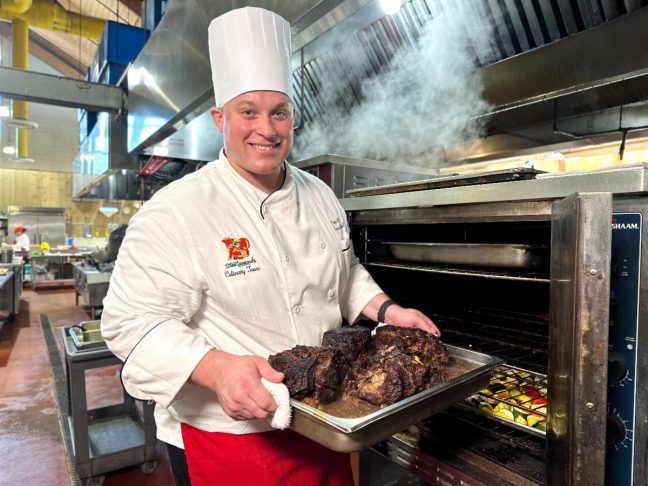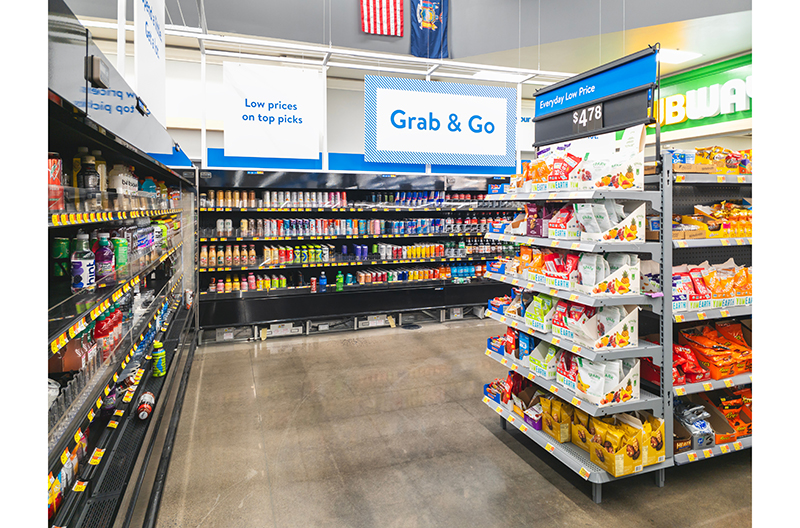Customers at the new Niemann Harvest Market that opened May 15 in Carmel, Indiana, have a wide range of innovative options when it comes to picking up fresh food for any time of day, from grab-and-go meals to fresh-cut meats and produce.
And it has experts at its service counters who can provide input as needed.
“Because we do so many different things from scratch, when you interact with one of the associates at a service counter, you can say, ‘What’s in this?’ And they can tell you because they’ve probably made it,” Store Director Sean Olson told The Shelby Report in early June.
The store features a full-service bar and restaurant that serves local craft beer, wine and cocktails. The eatery sources its food and ingredients from the store.
A butter-churning room adjacent to the dairy department uses local sweet cream to churn butter that is not only sold in the store but used in recipes produced in the restaurant, scratch bakery and deli. The buttermilk that’s churned is used to make biscuits and other scratch items.
Chefs are employed in the restaurant and deli. Meat from local farmers is roasted in-house and prepared for customers, along with a selection of items in the hot and cold cases.
This includes salads, lasagna, grilled salmon and chicken, Salisbury steak, meatloaf and “a wide variety of items that are restaurant-caliber,” Olson said.
The market’s gourmet sandwiches are made with in-house-roasted meats, along with a selection of Boar’s Head meats and cheeses.

The store could accurately be described as hyper-local.
“Everything that we do starts with partnerships with local producers and makers,” he said, adding that a producer is someone who grows something from the ground or raises livestock, while a maker is someone who adds value to those items.
Olson said every egg cracked at the store – in the bakery, deli or restaurant – comes from Little Farm on the Prairie. The sweet cream used by the store comes from a dairy farm in Wayne County.
Story cards are found throughout the store, informing guests about the local producers and makers.
Olson said the focus on making food from scratch – with an attention to quality and understanding what goes into making those products – is part of the desire to interact with guests “over a shared mutual passion for food, so people aren’t just pulling a premade item out of a box.”
Reaction from guests usually begins the same way.
“We get a lot of ‘wow,’” Olson said. “It’s a brand-new store, and that attention to detail is immaculate – from the décor down to the cases that we’ve picked out and the messaging that we have.
“We like to connect – again, going back to our mission statement, which is to connect our guests to the farmers and to the food makers and to the land – and one of the ways we do that is through the signage,” Olson said.
Olson also appreciates the opportunities to build relationships with shoppers.
“We get to do things from scratch, and we get to be creative. We create our own items at store level many times and embrace new recipes and new ideas. It makes it a fun place to be,” he said. “It’s about giving our guests a unique shopping experience that’s enjoyable. It’s about good food that tastes great, always.”
NRF unveiled Foodservice Innovations in special show zone
The National Retail Federation featured a Foodservice Innovation Zone – its first iteration – at NRF 2024: Retail’s Big Show early this year.
The goal for that area of the show floor, according to the NRF, was to showcase cooking equipment and AI-driven customer service solutions that are “redefining the retail landscape and showing how retailers can incorporate foodservice into their retail operations.”
After the show, Rob Grimes, founder and CEO of the International Food and Beverage Technology Association, NRF’s concept partner in the Foodservice Innovation Zone, blogged about what took place in the zone, which featured life-sized holograms of Grimes; NRF President and CEO Matthew Shay; and PepsiCo Foods North America CEO Steven Williams.
Each responded to attendee questions and talked about their organizations with the help of AI provided by Conversa.ai.
“The reason it’s there isn’t just to say, ‘Oh wow, that’s cool,’” Grimes wrote of the holograms. “It’s actually about delivering customer service that way – and getting some personality back into the conversation.”
Vendors in the zone demonstrated the use of AI in security, drive-thrus, embedded equipment for health, temperature and utility monitoring and customer service, he said, adding that “the hope is that the Foodservice Innovation Zone showed applicable, useful solutions.”

The drive-thru area, for example, included LetzChat, which provides real-time translation into more than 100 languages. It was demonstrated on a menu board as well as ordering kiosks.
Computer-vision vending machines are designed to help create frictionless experiences, Grimes noted. These can produce made-to-order hamburgers and hot dogs served on toasted buns with cheese, ketchup and mustard.
The most popular tour at the expo was the AI Retail Playbook, created with retailer feedback, said Dan Hodges, founder and CEO of Consumers in Motion Group. The two-hour tour was expert-led and focused on “market-leading technologies in customer management, including utilizing AI for personalization, operations, training and talent development, seamless integration of the physical and digital customer journey and utilizing ChatGPT.”
Hodges noted after the show that attendees were particularly interested in AI case studies. “People want to be more aware of the possibilities,” he said. They also enjoy learning from each other and networking with other leaders who have already solved the issues they face, he added.
Meal inspiration found throughout Vallarta store
Vallarta Supermarkets opened its first store in Santa Cruz County, California, on June 12, bringing its bountiful fresh departments to shoppers in the Watsonville area.
In addition to a produce department that features items from local growers, across the U.S. and around the world, the Watsonville Vallarta offers these departments:
- Pescaderia: This area includes an in-house Cevicheria, with a selection of fresh and frozen seafood from all over the world.
- Tortilleria: Customers can buy homemade fresh corn and flour tortillas every day.
- Cremería: Vallarta’s deli features a selection of house-made cremas from Mexico and Central America.
- Panaderia: Shoppers can find Latin American breads like conchas, puerquitos, mantecadas and bolillos.
- La Isla: A juice bar with fresh-pressed fruit and vegetable juices.
In the Carnes Frescas department, shoppers can buy the grocer’s carne asada, which is marinated with a blend of spices and fresh ingredients. The store offers a variety of American meat cuts and carries USDA choice Tomahawk steak, a thick-cut ribeye steak not commonly found at other grocers.
“We are looking forward to serving the community and providing new jobs in the area,” said COO Cesar Gonzalez. “As with all our Vallarta Supermarkets locations, we are dedicated to providing quality products and delivering exceptional customer service while fostering community growth and well-being.”
The new Watsonville store joins Vallarta’s other 55 stores in California.
Invafresh adds capabilities to popular Recipe Manager
Toronto-based fresh grocery platform Invafresh has expanded the capabilities of its Recipe Manager product.
Announced in May, the features help grocery retailers improve traceability of ingredients and products throughout the supply chain, implement strong quality control measures and develop nutrition ingredient food labels that comply with industry regulations. Recipe Manager is part of Invafresh’s AI-enhanced Fresh Retail Platform.
Invafresh said the changes to Recipe Manager will enhance consumer trust and safety, thanks to the ability to approve ingredients. Ingredients can be linked to manufacturers, ensuring regulatory compliance and adherence to labeling requirements. This reduces the risks associated with non-compliance penalties, product recalls and damage to a retailer’s reputation, according to Invafresh.
Other improvements include the grouping of allergens to facilitate regulatory compliance and provide clear information to consumers.
In addition, simplified and standardized labeling processes with preconfigured extra text capabilities allow for consistency in labeling, saving valuable time and resources, the company added.
Vineet Gupta, chief information officer for The North West Company, which operates 228 stores in Canada, Alaska, the South Pacific and the Caribbean, said, “Extending our relationship with Invafresh to include Recipe Manager will help take our operations to the next level in the use of analytics to deliver an improved customer experience.
“Having Invafresh as the foundational technology for our perimeter store operations, including deli, meat, bakery and produce, will allow us to scale efficiently as the business grows.”
Added Richard Weber, director of IT for Strack & Van Til, operator of 22 stores in Indiana: “Our use of the Invafresh Recipe Manager solution will enable us to centralize the creation, storage and management of all recipes for retail products produced in-store.”
Grocers broaden use of platform
Invafresh is being used in more than 350 grocery retailers in 35 countries. Among them is Stew Leonard’s, which has seven stores in Connecticut, New York and New Jersey. (An eighth is expected to open this year in Clifton, New Jersey.)
Earlier this year, the grocer expanded its relationship with Invafresh to include recipe management capabilities.

“For our team members, Invafresh will provide better visibility into recipe ingredients, so they don’t have to reinvent the wheel each time they create an item for our in-store menu. That saves time and increases the operational efficiency of our team,” said Rich Dibble, VP of culinary operations at Stew Leonard’s.
With the new capabilities, Stew Leonard’s chefs have the freedom to introduce recipes to the store’s 20 million annual customers and have a consistent product come out of all seven kitchens.
“With Invafresh, we can achieve consistency across our store operations when it comes to recipes and ensure we have the right ingredients available, which results in easier management of those recipes and a better shopping experience for our customers,” Dibble noted.
In May, California-based Gelson’s Markets announced it had expanded its partnership with Invafresh to include in-store production and centralized kitchen operations.
By using the AI-enhanced capabilities of the Invafresh Fresh Retail Platform, Gelson’s has been able to improve operational efficiency across its 27 stores by reducing shrink, ensuring compliance with regulatory requirements and having a centralized repository of more than 4,700 recipes, allowing for easy management from a data and cost perspective.
Now, Gelson’s has added production planning and commissary solutions with Invafresh for visibility across their entire fresh food retail operations for in-store and central kitchen operations.
“With Invafresh, we have an AI-enhanced solution that provides seamless integration across our entire fresh food operations, helping us to increase margins and revenues and reduce food waste,” said Ron Johnson, chief information and supply chain officer at Gelson’s.
“For Gelson’s, the benefits of using the Invafresh … solutions will be increased quality, better assortment compliance, reduced shrink and an efficient management of labor resources. For our in-store associates, Invafresh provides an easy-to-manage workflow between stores and our central kitchens, while providing them with a feature-rich, mobile solution to better serve our customers.”

